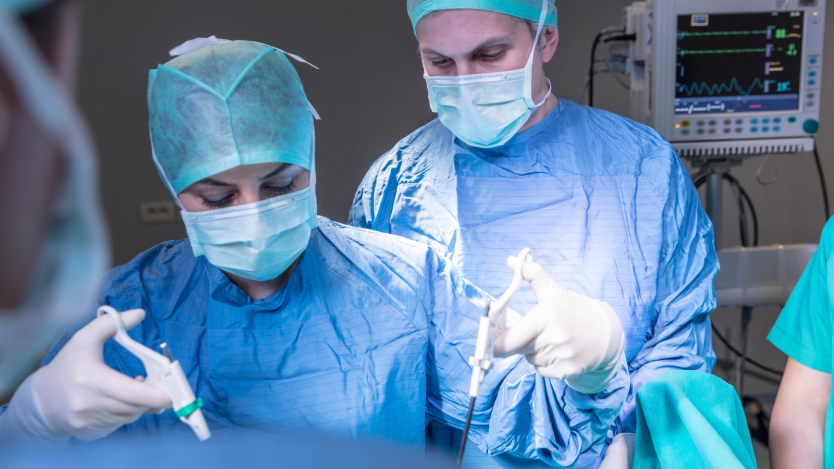Umbilical hernia surgery: types, advantages and complications

- Why is umbilical hernia surgery performed?
- Who is a candidate for umbilical hernia surgery?
- Types of umbilical hernia surgery
- Advantages of umbilical hernia surgery
- Complications of umbilical hernia surgery
- Request your free surgical assessment consultation with Operarme
- Umbilical hernia is the displacement of intra-abdominal contents into the umbilicus. The intestine can protrude through the hernia causing strangulation, which is a medical emergency.
- The umbilical hernia operation is performed on an outpatient basis, so the patient can leave the hospital the same day of the operation and resume normal activities such as driving or exercising.
- Umbilical hernia is very common in situations where there is an increase in abdominal pressure, as in the case of pregnancy.
Why is umbilical hernia surgery performed?
Umbilical hernia is characterised by the appearance of a bulge in the region of the umbilicus which is formed by fat or part of the intestine. This portion of the small intestine manages to pass through the muscle of the abdomen due to abdominal pressure, sometimes caused by overweight problems.

Do you need umbilical hernia surgery?
Request a free and immediate appointment with our specialists in General Surgery
However, you probably already know what an umbilical hernia is and are looking for some information about umbilical hernioplasty. Therefore, the first question we would like to answer is about the reasons why umbilical hernia surgery is performed.
This operation is performed in order to repair the abdominal wall and return the abdominal cavity, organs and extruded tissues to the interior. In this way, the abdominal wall is reinforced with a surgical mesh.

Some of the reasons for umbilical hernia surgery include the following:
- To eliminate symptoms
- To restore quality of life
- To prevent possible complications
Complications of umbilical hernia
An umbilical hernia is not normally a cause for concern, i.e. a medical emergency. However, when the contents of the hernia become trapped and cannot be reduced within the abdomen, it results in an emergency situation known as a strangulated umbilical hernia.
In cases of strangulated umbilical hernia, umbilical hernia surgery is necessary and urgent.
This condition implies that the part of the intestine that is trapped has poor blood circulation, which can cause tissue death.
It is important to know that this complication can appear in people who have had an umbilical hernia for a few days, as well as in those who have had it for many years and regardless of the size.
Who is a candidate for umbilical hernia surgery?
Increased abdominal pressure can lead to umbilical hernias, for example in pregnancy.
During pregnancy, the pressure inside the belly increases and an opening may develop in the muscle, due to its fragility. This increases the likelihood of a hernia developing.
However, the umbilical hernia in these cases does not pose a danger to the baby or to the mother's health, nor does it pose a risk to labour. It is still appropriate for the surgeon to assess the size of the hernia and indicate the use of a girdle during pregnancy.
In these cases, the surgeon may decide to postpone the operation until after delivery, or to do it altogether if the baby is delivered by caesarean section.

Umbilical hernia is also very common in babies, in fact it is estimated that 20% of newborns suffer from it. However, umbilical hernia is not considered to be a disease.
The umbilicus is the site of insertion of the umbilical cord in the embryonic stage, which passes through the muscles of the abdominal wall. After birth, this hole closes naturally. Failure to do so can lead to umbilical hernia, allowing the passage of intra-abdominal contents out of the umbilical cord.
This lump appearing in the abdomen is mobile and soft and can shrink. However, it can evolve, preventing its reintroduction and causing a much more serious medical condition.
Normally, in infants, it resolves spontaneously over time.
Umbilical hernia surgery in infants is necessary when the protrusion changes colour, is hard and causes the child to cry.
Umbilical hernia in adults is also very common. In fact, 5% of the population has or has had an abdominal hernia and 10% of these are umbilical hernias.
Depending on their origin, umbilical hernias can be classified as follows:
- Primary: they appear from newborns, due to a defect in the closure of the abdominal wall that causes weakness in the abdominal wall.
- Incisional: they appear after a surgical intervention that has presented weaknesses in the suture or in the internal surgical wound and that develops with continued physical overexertion.
In any case, umbilical hernioplasty can be performed using two surgical techniques, both of which are more or less invasive. If you want to know which are the two main techniques for this surgery, we tell you about them in the following section.
Types of umbilical hernia surgery
Umbilical hernia is a condition that occurs in the umbilicus, due to a defect in the abdominal wall and manifests itself as a bulge. Although there is the possibility of conservative treatment with the use of a girdle, or waiting to see how it evolves on its own, it is important to know that surgical treatment is the only effective treatment.

Umbilical hernia surgery can be performed using two techniques:
- Open: this consists of making an abdominal incision, below or above the navel, until the hernia is reached. Once the hernia is located, the doctor places the tissue inside the abdomen and places a surgical mesh in order to prevent muscular displacement to the outside. The surgeon then completes the umbilical hernia surgery by suturing layer by layer.
Open umbilical hernia surgery is done on an outpatient basis and lasts 30 - 40 minutes.
- Laparoscopy: this is a minimally invasive technique in which 3 mini-incisions are made in the abdomen, through which the instruments are inserted to repair the hernia defect. Using the laparoscope, the surgeon visualises the inside of the patient and operates on the hernia, following the same steps as with open surgery.
In both cases, the patient can leave the hospital on the same day as the operation, although, depending on the patient's condition, he or she may stay up to a couple of days in hospital. In any case, the stay rarely exceeds 48 hours.
Regardless of the technique used in umbilical hernia surgery, recovery will never exceed 4 weeks.
Advantages of umbilical hernia surgery
Umbilical hernia surgery has one main and obvious benefit, and that is the cessation of all symptoms caused by the umbilical hernia. By placing the intestine in its original place and repairing the hernia defect, the patient can return to normality and regain his or her quality of life.
Among the most important advantages after umbilical hernia surgery are the following:
- Avoid possible complications. One of the most dangerous associated pathologies is strangulated hernia. Umbilical hernia surgery completely eliminates the possibility that this condition, explained in the first point, can develop.
- Avoid complications in the case of children. Normally, specialists recommend waiting for the hernia to close on its own and wait until the child is 4 or 5 years old. However, umbilical hernioplasty is indicated to prevent an intestinal loop from becoming trapped in the hernia. This situation poses a danger to the child.
- Resuming activities. After the operation and the recovery period, the patient can return to normal activities, such as driving or high-performance exercise, without worrying about the hernia continuing to grow.
- Aesthetics. Although the main objective and benefit of the operation is the increase in quality of life, in terms of health, it is true that after umbilical hernia surgery, the bulge above the navel disappears. Therefore, the abdomen looks completely normal again.

Do you need umbilical hernia surgery?
Request a free and immediate appointment with our specialists in General Surgery
Complications of umbilical hernia surgery
In general, complications of umbilical hernia surgery are very low. In this case, it will be the patient's health situation that may cause a higher risk for the intervention. However, before surgery, a preoperative examination is carried out to check that the patient is fit for the operation and that there is no risk involved.
Umbilical hernia surgery has a very low complication rate.
The likelihood of complications is the same as for any other operation. Thus, these complications are related to the following factors:
- Anaesthesia
- Bleeding or infection
- Blood clots
- Breathing problems
However, there is nothing to worry about. As we said, a medical analysis is carried out prior to the umbilical hernioplasty to rule out any possible risks.
Request your free surgical assessment consultation with Operarme
If you would like to request a free surgical assessment consultation with one of our specialists, we would like to remind you that at Operarme we offer it free of charge, immediately and without any obligation.

At this consultation, the doctor will study your case and determine whether your condition presents an emergency situation.
It is therefore important that you bring all the medical tests you have undergone to this first appointment so that the specialist can make a more accurate surgical diagnosis.
If you would like to book your consultation, or to find out more about the services provided by Operarme for Umbilical hernia surgery, you can contact us on +34 91 141 33 56 or fill in the contact form.
In either case, a member of the Operarme’s Patient Service Team will contact you as soon as possible.

Do you need umbilical hernia surgery?
Request a free and immediate appointment with our specialists in General Surgery
Medical disclaimer: All the published content in Operarme is intended to disseminate reliable medical information to the general public, and is reviewed by healthcare professionals. In any case should this information be used to perform a diagnosis, indicate a treatment, or replace the medical assessment of a professional in a face to face consultation. Find more information in the links below:
